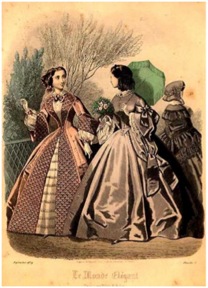Expectations of a Lady: Women Nurses in the Civil War—part one
 part one in a series
part one in a series
Before we examine the role of women as nurses in the Civil War, a brief literature review can help us better understand the expectations of an Antebellum lady. In 1966 Barbara Welter, in her description of the attributes of ‘True Womanhood’ for the period of 1820-1860, divided the attributes into four cardinal virtues.
Piety
The core of these values was religion. According to men of that timeframe as well as women, they believed women were given religious piety as a gift of God, and this gift meant that it was in a woman’s nature to be religious. Likewise society regarded a woman who was irreligious to be “the most revolting creature in human character.”
Purity
Purity was second in importance to piety. It was believed that if a woman became what was known as “fallen,” she would then most likely go mad or die. It was also strongly thought that a woman could control herself as well as shun a man who would make advances upon her, and if she did this, the men in turn would be grateful that the woman saved him from committing such a brutish act.
Submissiveness
Women were to be passive and respond to men, all while ensuring she adhered to piety and purity.
Domesticity
She was to only concern herself about domestic affairs.
Linda Kerber in her 1988 article, “Separate Spheres, Female Worlds, Woman’s Place: The Rhetoric of Women’s History” explains the historiography from 1966 until the mid-eighties of scholars’ understanding of Welter’s implication of separate spheres. In 1968, Eileen Kraditor contrasted “autonomy” with “women’s proper sphere.” She further argued that men had never had the restrictions of a sphere, since their sphere was “the world and all its activities.” She also linked the separate spheres with the Industrial Revolution. This new thinking was provided by the distinctions of men’s and women’s occupations.
Gerta Lerner’s “The Lady and the Mill Girl” took a step further with Kraditor’s argument about the link between spheres and industrialization. She argued that because industry needed women’s labor, she further interpreted the “cult of womanhood” to be a vehicle for middle class women to elevate their own status. Nancy Cott explored how the woman’s sphere was practiced by middle-classed women in New England, and how this ideal emphasized the complexity of the role of motherhood. In addition, she demonstrated how the only way women could purposefully connect to the community was through organized church groups.
The separate spheres and the Cult of Womanhood as described above applies mostly to the Northern wealthy and middle class women, but what about the Southern women? An interesting book by Christie Anne Farnham, The Education of the Southern Belle: Higher Education and Student Socialization in the Antebellum South, contrasts both higher education in the North to the South as well as the North’s version of the Cult of Womanhood to the Southern counterpart of these ideals. For this article we will confine this to expectations of women’s behavior. According to Farnham, because the South was tied to commercial agriculture and racial segregation, the South merged the separate spheres ideology with ideas of chivalry. Ladies in the South were educated in classical studies and in leisure activities such as needlework, dancing, and in various types of musical singing or playing an instrument. The South educated southern women not to work, but to become cultured and to marry. The young belle was taught to initiate courtships by flirting with men and to become sought after by them. Of course, like the North, virtue was practiced.
Again, we must keep in mind, these behavior expectations were ideals in both the North and the South and was primarily practiced by white middle and upper class women in the North, and by the wealthy upper class women in the South.
———-
References:
Kristie Ann Farnham, The Education of the Southern Belle: Higher Education and Student Socialization in the Antebellum South, (New York: New York University Press, 1994).
Linda Kerber, “Separate Spheres, Female Worlds, Woman’s Place: The Rhetoric of Women’s History,” The Journal of American History 75, no. 1 (June 1998): 12.
Barbara Welter, “The Cult of True Womanhood: 1820-1860,” American Quarterly 18, no. 2 (Summer 1966): 152-154.